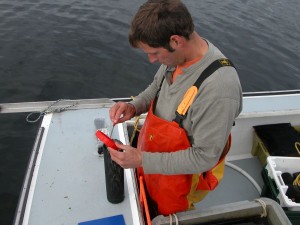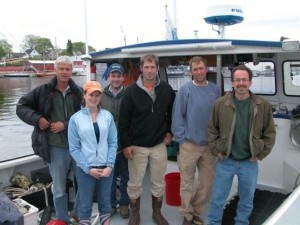Sea Urchin Nursery Methods
Suspended vs on-bottom nursery cages for sea urchins
An important consideration when out-planting hatchery reared sea urchins (seed) on bottom is the optimum release size. Studies in Japan and elsewhere report better survival with larger seed size of 15 mm to 20 mm test diameter (TD). However, it takes several months to grow seed urchins up to this size, and the extra culture time adds considerably to cost, especially if it takes place on land in tanks or raceways. Sea based nurseries may be a less costly alternative, but it is important that the seed be contained, fed and sheltered from predators during this vulnerable period. Larry Harris at the University of New Hampshire has tested various sea based nursery methods over the years, and in 2004 and again in 2006 we teamed up with him on two projects that addressed this question.
In the first project we tested suspended plastic mesh envelopes filled with shell hash substrate conditioned with biofilm prior to stocking. The biofilm provided a natural feed for the seed urchins to graze upon while in the envelopes. The containers were suspended from lines in a 300,000 gallon outdoor tank at the CCAR for six months. At the end of the six months they were opened and the urchins were counted and measured. Growth was good but recovery was low, as it appeared that many of the tiniest seed urchins had escaped their containers.
In the second project, funded through the USDA Small Business Innovation Research (SBIR) program, we tested an on-bottom nursery approach at two experimental lease sites in Penobscot Bay owned by our industry partner Friendship International. Small urchins less than 10 mm TD were collected from the lease areas and placed into plastic mesh cylinders (50 urchins per cylinder), which were then anchored on bottom by divers. After six months the cylinders were collected and the urchins were counted and measured. Although we didn’t add feed to the cylinders during the 6-month study, survival and growth were good overall, but different between the two lease sites. Differences in growth and survival were possibly due to site characteristics such as bottom substrates and flow patterns.
Results from this study were published in the Journal of Shellfish Research as: Kirchhoff, N., Eddy, S., Harris, L. and Brown, N. 2008. Nursery-phase culture of green sea urchin Strongylocentrotus droebachiensis using “on-bottom” cages. Journal of Shellfish Research. 27(4):921-927.


